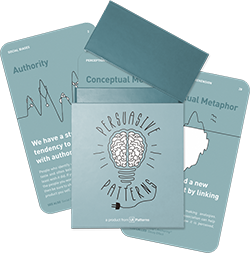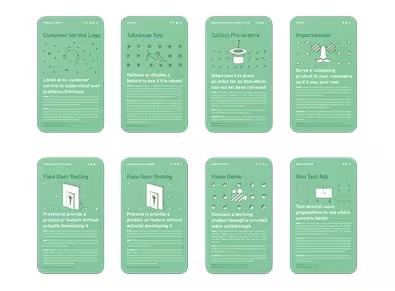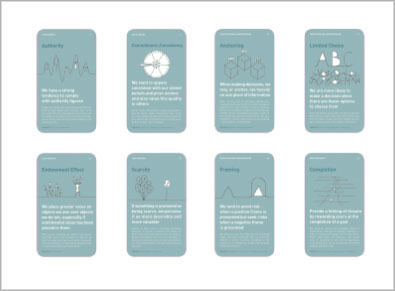Authority Bias
Design Pattern
Problem summary
We have a strong tendency to comply with authority figures
Usage
- Use when you are promoting products or services backed by genuine expert endorsements, ensuring that the authority figures truly support what they’re endorsing.
- Use when educating your audience on complex topics where expert insight can simplify understanding and foster trust.
- Use when building brand credibility by associating your offerings with recognized and respected authorities in your industry.
- Use when you aim to leverage social proof in marketing strategies, aligning your product with societal values or expert recommendations to encourage adoption.
- Do not use when the authority figure’s expertise or credibility is not directly relevant to the product or service being endorsed, which could mislead consumers.
- Do not use when relying on authority bias could overshadow the intrinsic value or quality of the product, suggesting reliance on external validation over substance.
- Do not use when there’s a risk of ethical concerns or misrepresentation, especially if the authority’s endorsement is exaggerated or fabricated.
- Do not use when the use of authority bias might alienate or patronize your target audience, especially if they value independent research and critical thinking over authoritative guidance.
This card is part of the Persuasive Patterns printed card deck
The Persuasive Patterns Card Deck is a collection of 60 design patterns driven by psychology, presented in a manner easily referenced and used as a brainstorming tool.
Get your deck!Solution
When determining who is an authority, we have surprisingly low standards and respond instinctively. A blue uniform represents a policeman who should be obeyed, a white lab coat and stethoscope represents a doctor who’s advice we should consider, and a man in a business suit must represent a respected business man who’s opinions we should listen to.
Cialdini found three significant symbols of authority that will reliably trigger our compliance in the absence of the genuine substance of authority: titles, clothes, and trappings (jewelry, cars, etc.)1.
Communicate authority
Communicate a sense of authority to your users by displaying appropriate credentials. List certifications, awards, or prominent customer testimonials. Associate yourself with authority figures by connecting their well-known face with your product.
Choose an authority figure depending on your business, who you want to influence, and how you want to influence them. Here are a few of examples:
- Use prominent athletes if you want to sell the products they use.
- Use doctors and nurses on health related websites.
- Use famous chefs if you want to sell food.
Study who represent authority in your field and in what way your users will comply with their message.
You however don’t have to associate yourself with authority figures to communicate authority. Act like one yourself! Speak with confidence, lead discussions, blog, post videos, or find another way of establishing yourself or your company as an authority figure.
Rationale
Authority bias is a cognitive bias that leads people to attribute greater accuracy and credibility to the opinions of an authority figure, regardless of the actual content of their claims. This bias can occur in various contexts, including decision-making processes, where individuals may disproportionately weigh the opinions of experts or leaders. It is influenced by societal norms and cultural conditioning, which teach individuals to respect and follow the guidance of those perceived as authorities.
This bias is not limited to interactions with recognized experts or leaders but can also manifest in situations where an individual appears authoritative due to their demeanor, attire, or the context in which they are presenting information. For example, someone wearing a lab coat or a uniform may be perceived as more knowledgeable or trustworthy, even if they have no expertise in the subject matter they are discussing.
Authority bias can lead to a number of consequences, both positive and negative. On the positive side, it can facilitate efficient decision-making when it encourages people to defer to experts in complex or specialized fields where they lack knowledge. However, it can also lead to negative outcomes, such as the uncritical acceptance of flawed ideas, obedience to harmful directives, or the perpetuation of misinformation. In extreme cases, authority bias can contribute to the development of cults of personality, where individuals are followed or idolized to a harmful extent.
Identifying with Authority Figures
People, who identify with authority figures, trust their taste and often believe that it fits their own – or at least they wish it did. If you have experts on your team, or if the people you work with are in some way authorities, then be sure to show them off to lend credibility to the product you sell.
We have a sense of duty to authority that makes us unable to defy their wishes. Authority help define the role we take upon ourselves and the roles we put on others. If an authority figure is seen as a teacher, we put on the learner or student role. If a policeman approaches us we take on the role as a suspect or informer.
We rarely agonize over the pros and cons that authority demands. With little or no conscious deliberation, we see information from a recognized authority as a valuable shortcut for deciding how to act in a situation. Authority positions speak of superior access to information and power, why it makes sense to comply with the wishes of properly constituted authorities.
Once a legitimate authority has given an order, subordinates stop thinking in the situation and start reacting. Often the appearance of authority is enough – we don’t always need to provide real authority. A uniform or famous face can do. We are often as vulnerable to the symbols of authority as to the substance.
Discussion
While leveraging authority bias can be effective, it’s also important to provide substantive value and evidence supporting the quality and benefits of your offerings. Relying solely on authority bias without backing it up with quality can lead to short-term gains but potentially damage your brand’s reputation in the long run.
The study
In the early 1960s, an experiment was conducted that demonstrated the profound influence of perceived authority on individual actions. Participants believed they were assisting in a learning experiment and were instructed by a researcher to administer increasingly intense electric shocks to another participant (who was, unbeknownst to them, an actor and not actually receiving shocks). Despite hearing the actor’s fabricated screams of pain, a significant portion of the participants continued to administer shocks when prompted by the authoritative figure, showcasing the intense pull of Authority Bias2.
Powerful pairings
- Authority Bias & Social Proof. Combining the influence of recognized authority figures with the power of majority opinion can significantly enhance the persuasiveness of a message. For instance, a health app that cites a recommendation from a reputable medical institution and then showcases user testimonials or the number of downloads can significantly increase user trust and adoption.
- Authority Bias & Commitment & Consistency. When people see an authoritative figure endorse a particular behavior or product, they are more likely to commit to it. Once committed, due to the principle of consistency, they are likely to continue with that behavior or use the product consistently. An example could be a fitness program endorsed by a renowned athlete; users who commit to this program are more likely to stick to it in the long run.
- Authority Bias & Reputation. Authority figures often have established reputations, which can be harnessed to bolster the credibility of a product or service. A skincare product line co-developed with a respected dermatologist can be perceived as more trustworthy than one without such an endorsement.
- Authority Bias & Storytelling. Combining a narrative with the endorsement or opinion of an authority figure can be a powerful tool. When a compelling story, perhaps of the authority figure’s personal experience or journey, is interwoven with the message, it becomes more relatable and memorable. For instance, a financial planning tool might share a story of a renowned economist who once struggled with managing personal finances but found solace and success using this specific tool.
Ethical Recommendations
The power of Authority Bias in shaping perceptions and driving behavior is undeniable. However, like all influential tools, it holds the potential for misuse. One of the primary concerns is the fabrication or exaggeration of authority. Brands or individuals might falsely claim endorsements, present fabricated credentials, or use symbols of authority without the substance behind them. Such practices can mislead users into making decisions that may not be in their best interest.
An over-reliance on authority can stifle critical thinking. By positioning a product, service, or idea as authoritative, users might be discouraged from seeking alternative viewpoints or conducting their own research. This can lead to an uninformed populace that merely adheres to perceived authority rather than making well-considered decisions.
To ensure that the use of Authority Bias remains ethical and user-centric, several best practices are recommended:
- Transparency and authenticity. Only use genuine symbols of authority. If presenting credentials, endorsements, or affiliations, ensure that they are legitimate and verifiable. Avoid exaggerating claims or using vague language that might mislead users about the extent of your authority or expertise.
- Encourage critical thinking. While leveraging authority can be effective, it’s essential to encourage users to think critically. Offer them resources, alternative viewpoints, or avenues to conduct their own research. This not only respects their autonomy but also fosters an environment of informed decision-making.
- Regularly review and update claims The landscape of any industry or field can change over time. What was once considered authoritative might no longer hold that status. Regularly review and update any claims of authority to ensure they remain current and relevant.
- Educate and inform. Rather than merely presenting yourself or your product as an authority, take the extra step to educate your users. Provide them with information, resources, and insights that reinforce your authoritative stance while also empowering them with knowledge.
Ethical utilization of the Authority Bias requires a delicate balance between asserting authority and respecting user autonomy, ensuring that trust is built on genuine expertise and transparency.
1 Cialdini, R. (1993), Influence: Science and practice (3rd edn), New York: HarperCollins
2 Milgram, S. (1963). Behavioral study of obedience. Journal of Abnormal and Social Psychology, 67(4), 371-378.
3 Burger, J. M. (2009). Replicating Milgram: Would people still obey today? American Psychologist, 64(1), 1-11.
4 Blass, T. (1999). The Milgram paradigm after 35 years: Some things we now know about obedience to authority. Journal of Applied Social Psychology, 29(5), 955-978.
5 Milgram, S. (1974). Obedience to authority: An experimental view. Harper & Row.
6 Cialdini, R. B. (2009). Influence: Science and practice (5th ed.). Allyn & Bacon.
7 Cosmides, L., & Tooby, J. (1992). Cognitive adaptations for social exchange. In J. H. Barkow, L. Cosmides, & J. Tooby (Eds.), The adapted mind: Evolutionary psychology and the generation of culture (pp. 163-228). Oxford University Press.
8 Moe, W. W. (2003). Buying, searching, or browsing: Differentiating between online shoppers using in-store navigational clickstream. Journal of Consumer Psychology, 13(1-2), 29-39.
9 French, J. R. P., & Raven, B. (1959). The bases of social power. In D. Cartwright (Ed.), Studies in social power (pp. 150-167). Institute for Social Research.
10 Barber, B. M., & Odean, T. (2001). The internet and the investor. Journal of Economic Perspectives, 15(1), 41-54.
11 Agarwal, R., & Day, A. E. (1998). The impact of the Internet on economic education. The Journal of Economic Education, 29(2), 99-110.
12 Fogg, B. J. (2003). Persuasive technology: Using computers to change what we think and do. Morgan Kaufmann Publishers.
13 Chaiken, S. (1980). Heuristic versus systematic information processing and the use of source versus message cues in persuasion. Journal of Personality and Social Psychology, 39(5), 752.
14 Cialdini, R. B., Trost, M. R., & Newsom, J. T. (1995). Preference for consistency: The development of a valid measure and the discovery of surprising behavioral implications. Journal of Personality and Social Psychology, 69(2), 318.
15 Eagly, A. H., Wood, W., & Chaiken, S. (1978). Causal inferences about communicators and their effect on opinion change. Journal of Personality and Social Psychology, 36(4), 424.
16 Green, M. C., & Brock, T. C. (2000). The role of transportation in the persuasiveness of public narratives. Journal of Personality and Social Psychology, 79(5), 701.
17 Brown, R., & Hauenstein, N. M. A. (2005). Interrater agreement reconsidered: An alternative to the rwg indices. Organizational Research Methods, 8(2), 165-184.
18 Bandura, A. (1977). Social learning theory. Prentice-Hall.
19 Authority Bias at Learning Loop
User Interface Design Patterns
- Forms
- Explaining the process
- Community driven
- Tabs
- Jumping in hierarchy
- Menus
- Content
- Gestures
- Tables
- Formatting data
- Images
- Search
- Reputation
- Social interactions
- Shopping
- Increasing frequency
- Guidance
- Registration
Persuasive Design Patterns
- Loss Aversion
- Other cognitive biases
- Scarcity
- Gameplay design
- Fundamentals of rewards
- Gameplay rewards


